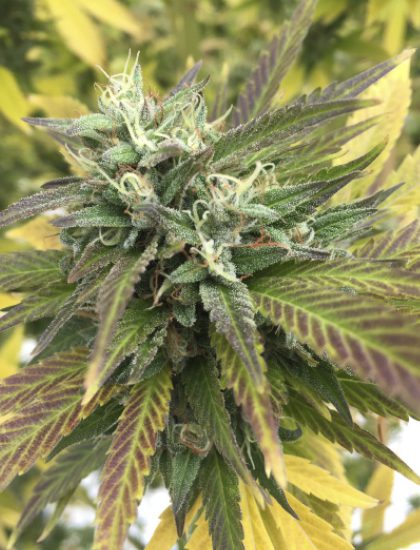Most growers I know are men. When I came across Oregon Girl Gardens, I was delighted to find the operation was headed by master grower: Robin Cordell. Cordell has extensive garden knowledge, including a Bachelor’s Degree of Science in Horticulture Science from Oregon State University. A questionable amount of growers in the cannabis industry do not always have a formal degree to back up their work. I was pleased to discover Robin was into sustainable horticulture, and had the formal education to back it up. Cordell is in the process of building a solid foundation for her business to grow from.
It felt good leaving the city and breathing in the fresh mountain air. The majority of Cordell’s staff was either trimming and/or processing flower from the fall 2017 harvest. Cordell insists upon hand-trimmed flower. Not a single bud was run through a trimming machine because the quality of the job isn’t up to her standard. True craft cannabis is hand trimmed until the finish. A labor of love, if you will. My respect for this woman was already soaring.
Cordell’s partner was setting up her brand new indoor space being prepared for flower. I asked her what lighting she was installing and why she chose it. Cordell chose to grow with LED Heliospectra lighting. After reading a New York Times article on how the Heliospectra LED’s saved energy, she began doing her own research. Cordell was looking to get the most out of her modest 200 amp garden and 200 amp greenhouse (400 amps total). Heliospectra lights come with a three-year warranty, and she is projecting to return her investment within 2 years.
Cordell could not stress enough how important critical decisions like lighting are for new starts-ups. “We do not have room for any screw-ups,” Cordell explained. If your lighting doesn’t preform, you might be out of business within a year or less. In an emerging, highly competitive cannabis market, lighting will make or break you. Cordell originally grew with double-ended galaxy lights, but wanted to reduce the amount of energy her new garden would consume.

“I don’t want to be a guinea pig. I want to be successful.” Robin stated. “So many companies are trying to sell you a product without any real evidence behind it.”
The shovels and buckets of this market are lighting and HVAC. Journeymen are looking to diversify and make a profit off a new, rapidly growing market. Finding trustworthy lighting, HVAC and build-outs is no laughing matter. Cordell does not want to grow with a trendy new light that may, or may not deliver. She wanted to invest in technology that she could succeed with from the get-go.
Cordell also has a background in retail in the garden world. Prior to starting Oregon Girl Gardens, she ran a hydro store. She was already fine-tuned for the market when looking to make a substantial investment in lighting. The Heliospectra LED light models boast they not only provide the intensity of light needed, but also the specific spectrums (red, blue) plants thrive in.
An ample amount of cannabis growers refuse to switch to LED’s because their tested methods produce their desired results. There isn’t necessarily anything wrong with not using LED’s, but the cannabis industry will be held accountable for its energy consumption (especially if it adversely effects our environment). Growers like Cordell looking to combat the issue of gross energy use from the gate, show good faith and market longevity in the race to the top.
Cordell also cultivates greenhouse-grown cannabis she’s looking to mod out with her new LED Heliospectra lighting. I do not believe I have met any grower (worth their salt) who claims to have it all mastered. It’s a constant game of dialing and refining. The cannabis “gold standard” of growing has yet to be revealed.
After grow-talk, Cordell grabbed a smattering of display jars filled with various strains from her garden. My favorite out of the bunch was her rendition of Plushberry. The flower boasted a typical royal purple fade, with a sweet, musky nose. The Obama I saw was impressive. Cordell’s outdoor, or “sun grown” flower was in excellent condition. I could have easily mistaken it for a batch of well-done greenhouse or a rough indoor flower.

You can see and smell the quality of Cordell’s flower. Each nug, hand-trimmed to perfection. I see so many growers looking to cut corners and ultimately the cost of their grow–which includes payroll. When machines replace humans, quality is likely to take a dive. Businesses who invest in their employees should be elevated as an example to all. In a world of growing income disparity, the cannabis industry has a duty to offer avenues of wealth to all looking to work for it.
I am looking forward to watching Cordell’s business grow in the face of tough regulation. It’s the beginning of an industry, and it’s promising to see women on the ground floor of the next big thing.

